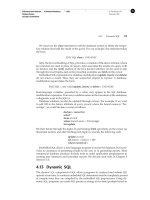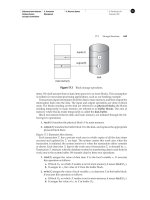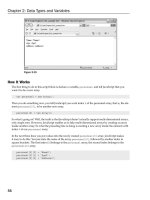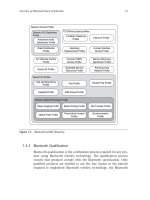Java Concepts 5th Edition phần 2 docx
Bạn đang xem bản rút gọn của tài liệu. Xem và tải ngay bản đầy đủ của tài liệu tại đây (1.19 MB, 111 trang )
Java Concepts, 5th Edition
17. 0
18. An accessor—it doesn't modify the original string but returns a new string
with uppercase letters.
19. box.translate(−5, −10), provided the method is called
immediately after storing the new rectangle into box.
20. x: 30, y: 25
21. Because the translate method doesn't modify the shape of the rectangle.
22. Add the statement import java.util.Random; at the top of your
program.
23. toLowerCase
24. “Hello, Space !”—only the leading and trailing spaces are trimmed.
25. Now greeting and greeting2 both refer to the same String object.
26. Both variables still refer to the same string, and the string has not been
modified. Recall that the toUpperCase method constructs a new string
that contains uppercase characters, leaving the original string unchanged.
27. Modify the EmptyFrameViewer program as follows:
frame.setSize(300, 300);
frame.setTitle(“Hello, World!”);
28. Construct two JFrame objects, set each of their sizes, and call
setVisible(true) on each of them.
29. Rectangle box = new Rectangle(5, 10, 20, 20);
30. Replace the call to box.translate(15, 25) with
box = new Rectangle(20, 35, 20, 20);
31. The compiler complains that g doesn't have a draw method.
32. g2.draw(new Ellipse2D.Double(75, 75, 50, 50));
79
80
Chapter 2 Using Objects Page 66 of 67
Java Concepts, 5th Edition
33. Line2D.Double segment1 = new Line2D.Double(0, 0,
10, 30);
g2.draw(segment1);
Line2D.Double segment2 = new Line2D.Double(10, 30,
20, 0);
g2.draw(segment2);
34. g2.drawString(“V”, 0, 30);
35. 0, 0, 255
36. First fill a big red square, then fill a small yellow square inside:
g2.setColor(Color.RED);
g2.fill(new Rectangle(0, 0, 200, 200));
g2.setColor(Color.YELLOW);
g2.fill(new Rectangle(50, 50, 100, 100));
Chapter 2 Using Objects Page 67 of 67
Java Concepts, 5th Edition
Chapter 3 Implementing Classes
CHAPTER GOALS
• To become familiar with the process of implementing classes
• To be able to implement simple methods
• To understand the purpose and use of constructors
• To understand how to access instance fields and local variables
• To appreciate the importance of documentation comments
G To implement classes for drawing graphical shapes
In this chapter, you will learn how to implement your own classes. You will start
with a given design that specifies the public interface of the class—that is, the
methods through which programmers can manipulate the objects of the class. You
then need to implement the methods. This step requires that you find a data
representation for the objects, and supply the instructions for each method. You then
provide a tester to validate that your class works correctly. You also document your
efforts so that other programmers can understand and use your creation.
3.1 Levels of Abstraction
3.1.1 Black Boxes
When you lift the hood of a car, you will find a bewildering collection of
mechanical components. You will probably recognize the motor and the tank for
the wind-shield washer fluid. Your car mechanic will be able to identify many other
components, such as the transmission and the electronic control module—the
device that controls the timing of the spark plugs and the flow of gasoline into the
motor. But ask your mechanic what is inside the electronic control module, and you
will likely get a shrug.
81
81
82
Chapter 3 Implementing Classes Page 1 of 71
Java Concepts, 5th Edition
It is a black box, something that magically does its thing. A car mechanic would
never open the box—it contains electronic parts that can only be serviced at the
factory. Of course, the device may have a color other than black, and it may not
even be box-shaped. But engineers use the term “black box” to describe any device
whose inner workings are hidden. Note that a black box is not totally mysterious.
Its interaction with the outside world is well-defined. For example, the car
mechanic can test that the engine control module sends the right firing signals to the
spark plugs.
Why do car manufacturers put black boxes into cars? The black box greatly
simplifies the work of the car mechanic, leading to lower repair costs. If the box
fails, it is simply replaced with a new one. Before engine control modules were
invented, gasoline flow into the engine was regulated by a mechanical device called
a carburetor, a notoriously fussy mess of springs and latches that was expensive to
adjust and repair.
Of course, for many drivers, the entire car is a “black box”. Most drivers know
nothing about its internal workings and never want to open the hood in the first
place. The car has pedals, buttons, and a gas tank door. If you give it the right
inputs, it does its thing, transporting you from here to there.
And for the engine control module manufacturer, the transistors and capacitors that
go inside are black boxes, magically produced by an electronics component
manufacturer.
In technical terms, a black box provides encapsulation, the hiding of unimportant
details. Encapsulation is very important for human problem solving. A car
mechanic is more efficient when the only decision is to test the electronic control
module and to replace it when it fails, without having to think about the sensors and
transistors inside. A driver is more efficient when the only worry is putting gas in
the tank, not thinking about the motor or electronic control module inside.
However, there is another aspect to encapsulation. Somebody had to come up with
the right concept for each particular black box. Why do the car parts manufacturers
build electronic control modules and not another device? Why do the transportation
device manufacturers build cars and not personal helicopters?
82
83
Chapter 3 Implementing Classes Page 2 of 71
Java Concepts, 5th Edition
Concepts are discovered through the process of abstraction, taking away inessential
features, until only the essence of the concept remains. For example, “car” is an
abstraction, describing devices that transport small groups of people, traveling on
the ground, and consuming gasoline. Is that the right abstraction? Or is a vehicle
with an electric engine a “car”? We won't answer that question and instead move on
to the significance of encapsulation and abstraction in computer science.
3.1.2 Object-Oriented Design
In old times, computer programs manipulated primitive types such as numbers and
characters. As programs became more complex, they manipulated more and more
of these primitive quantities, until programmers could no longer keep up. It was just
too confusing to keep all that detail in one's head. As a result, programmers gave
wrong instructions to their computers, and the computers faithfully executed them,
yielding wrong answers.
Of course, the answer to this problem was obvious. Software developers soon
learned to manage complexity. They encapsulated routine computations, forming
software “black boxes” that can be put to work without worrying about the
internals. They used the process of abstraction to invent data types that are at a
higher level than numbers and characters.
At the time that this book is written, the most common approach for structuring
computer programming is the object-oriented approach. The black boxes from
which a program is manufactured are called objects. An object has an internal
structure—perhaps just some numbers, perhaps other objects—and a well-defined
behavior. Of course, the internal structure is hidden from the programmer who uses
it. That programmer only learns about the object's behavior and then puts it to work
in order to achieve a higher-level goal.
83
84
Chapter 3 Implementing Classes Page 3 of 71
Java Concepts, 5th Edition
Figure 1
Levels of Abstraction in Automotive Design
Figure 2
Levels of Abstraction in Software Design
Chapter 3 Implementing Classes Page 4 of 71
Java Concepts, 5th Edition
Who designs these objects? Other programmers! What do they contain? Other
objects! This is where things get confusing for beginning students. In real life, the
users of black boxes are quite different from their designers, and it is easy to
understand the levels of abstraction (see Figure 1). With computer programs, there
are also levels of abstraction (see Figure 2), but they are not as intuitive to the
uninitiated. To make matters potentially more confusing, you will often need to
switch roles, being the designer of objects in the morning and the user of the same
objects in the afternoon. In that regard, you will be like the builders of the first
automobiles, who singlehandedly produced steering wheels and axles and then
assembled their own creations into a car.
There is another challenging aspect of designing objects. Software is infinitely
more flexible than hardware because it is unconstrained from physical limitations.
Designers of electronic parts can exploit a limited number of physical effects to
create transistors, capacitors, and the like. Transportation device manufacturers
can't easily produce personal helicopters because of a whole host of physical
limitations, such as fuel consumption and safety. But in software, anything goes.
With few constraints from the outside world, you can design good and bad
abstractions with equal facility. Understanding what makes good design is an
important part of the education of a software engineer.
3.1.3 Crawl, Walk, Run
In Chapter 2, you learned to be an object user. You saw how to obtain objects, how
to manipulate them, and how to assemble them into a program. In that chapter, your
role was analogous to the automotive engineer who learns how to use an engine
control module, and how to take advantage of its behavior in order to build a car.
In this chapter, you will move on to implementing classes. A design will be handed
to you that describes the behavior of the objects of a class. You will learn the
necessary Java programming techniques that enable your objects to carry out the
desired behavior. In these sections, your role is analogous to the car parts
manufacturer who puts together an engine control module from transistors,
capacitors, and other electronic parts.
In Chapters 8 and 12, you will learn more about designing your own classes. You
will learn rules of good design, and how to discover the appropriate behavior of
84
85
Chapter 3 Implementing Classes Page 5 of 71
Java Concepts, 5th Edition
objects. In those chapters, your job is analogous to the car parts engineer who
specifies how an engine control module should function.
SELF CHECK
1. In Chapters 1 and 2, you used System.out as a black box to cause
output to appear on the screen. Who designed and implemented
System.out?
2. Suppose you are working in a company that produces personal finance
software. You are asked to design and implement a class for
representing bank accounts. Who will be the users of your class?
3.2 Specifying the Public Interface of a Class
In this section, we will discuss the process of specifying the behavior of a class.
Imagine that you are a member of a team that works on banking software. A
fundamental concept in banking is a bank account. Your task is to understand the
design of a BankAccount class so that you can implement it, which in turn allows
other programmers on the team to use it.
You need to know exactly what features of a bank account need to be implemented.
Some features are essential (such as deposits), whereas others are not important (such
as the gift that a customer may receive for opening a bank account). Deciding which
features are essential is not always an easy task. We will revisit that issue in Chapters
8 and 12. For now, we will assume that a competent designer has decided that the
following are considered the essential operations of a bank account:
In order to implement a class, you first need to know which methods are required.
• Deposit money
• Withdraw money
• Get the current balance
In Java, operations are expressed as method calls. To figure out the exact
specification of the method calls, imagine how a programmer would carry out the
85
86
Chapter 3 Implementing Classes Page 6 of 71
Java Concepts, 5th Edition
bank account operations. We'll assume that the variable harrysChecking contains
a reference to an object of type BankAccount. We want to support method calls
such as the following:
harrysChecking.deposit(2000);
harrysChecking.withdraw(500);
System.out.println(harrysChecking.getBalance());
Note that the first two methods are mutators. They modify the balance of the bank
account and don't return a value. The third method is an accessor. It returns a value
that you can print or store in a variable.
As you can see from the sample calls, the BankAccount class should define three
methods:
• public void deposit(double amount)
• public void withdraw(double amount)
• public double getBalance()
Recall from Chapter 2 that double denotes the double-precision floating-point type,
and void indicates that a method does not return a value.
When you define a method, you also need to provide the method body, consisting of
statements that are executed when the method is called.
public void deposit(double amount)
{
body—filled in later
}
You will see in Section 3.5 how to fill in the method body.
Every method definition contains the following parts:
• An access specifier (usually public)
• The return type (such as void or double)
• The name of the method (such as deposit)
Chapter 3 Implementing Classes Page 7 of 71
Java Concepts, 5th Edition
• A list of the parameters of the method (if any), enclosed in parentheses (such
as double amount)
• The body of the method: statements enclosed in braces
The access specifier controls which other methods can call this method. Most
methods should be declared as public. That way, all other methods in a program
can call them. (Occasionally, it can be useful to have private methods. They can
only be called from other methods of the same class.)
A method definition contains an access specifier (usually public), a return type,
a method name, parameters, and the method body.
The return type is the type of the output value. The deposit method does not return
a value, whereas the getBalance method returns a value of type double.
SYNTAX 3.1 Method Definition
accessSpecifier returnType
methodName(parameterType parameterName, . . . )
{
method body
}
Example:
public void deposit(double amount)
{
. . .
}
Purpose:
To define the behavior of a method
Each parameter (or input) to the method has both a type and a name. For example, the
deposit method has a single parameter named amount of type double. For each
parameter, choose a name that is both a legal variable name and a good description of
the purpose of the input.
86
87
Chapter 3 Implementing Classes Page 8 of 71
Java Concepts, 5th Edition
Next, you need to supply constructors. We will want to construct bank accounts that
initially have a zero balance, by using the default constructor:
BankAccount harrysChecking = new BankAccount();
What if a programmer who uses our class wants to start out with another balance? A
second constructor that sets the balance to an initial value will be useful:
BankAccount momsSavings = new BankAccount(5000);
To summarize, it is specified that two constructors will be provided:
• public BankAccount()
• public BankAccount(double initialBalance)
A constructor is very similar to a method, with two important differences.
• The name of the constructor is always the same as the name of the class (e.g.,
BankAccount)
• Constructors have no return type (not even void)
Just like a method, a constructor also has a body—a sequence of statements that is
executed when a new object is constructed.
Constructors contain instructions to initialize objects. The constructor name is
always the same as the class name.
public BankAccount()
{
body—filled in later
}
The statements in the constructor body will set the internal data of the object that is
being constructed—see Section 3.5.
Don't worry about the fact that there are two constructors with the same name—all
constructors of a class have the same name, that is, the name of the class. The
compiler can tell them apart because they take different parameters.
87
88
Chapter 3 Implementing Classes Page 9 of 71
Java Concepts, 5th Edition
When defining a class, you place all constructor and method definitions inside, like
this:
public class BankAccount
{
// Constructors
public BankAccount()
{
body—filled in later
}
public BankAccount(double initialBalance)
{
body—filled in later
}
// Methods
public void deposit(double amount)
{
body—filled in later
}
public void withdraw(double amount)
{
body—filled in later
}
public double getBalance()
{
body—filled in later
}
private fields—filled in later
}
You will see how to supply the missing pieces in the following sections.
The public constructors and methods of a class form the public interface of the class.
These are the operations that any programmer can use to create and manipulate
BankAccount objects. Our BankAccount class is simple, but it allows
programmers to carry out all of the important operations that commonly occur with
bank accounts. For example, consider this program segment, authored by a
programmer who uses the BankAccount class. These statements transfer an amount
of money from one bank account to another:
// Transfer from one account to another
double transferAmount = 500;
momsSavings.withdraw(transferAmount);
Chapter 3 Implementing Classes Page 10 of 71
Java Concepts, 5th Edition
harrysChecking.deposit(transferAmount);
SYNTAX 3.2 Constructor Definition
accessSpecifier ClassName(parameterType
parameterName, . . . )
{
constructor body
}
Example:
public BankAccount(double initialBalance)
{
. . .
}
Purpose:
To define the behavior of a constructor
SYNTAX 3.3 Class Definition
accessSpecifier class ClassName
{
constructors
methods
fields
}
Example:
public class BankAccount
{
public BankAccount(double initialBalance) {. .
.}
public void deposit(double amount) {. . .}
. . .
}
Purpose:
To define a class, its public interface, and its implementation details
88
89
Chapter 3 Implementing Classes Page 11 of 71
Java Concepts, 5th Edition
And here is a program segment that adds interest to a savings account:
double interestRate = 5; // 5% interest
double interestAmount
= momsSavings.getBalance() * interestRate /
100;
momsSavings.deposit(interestAmount);
As you can see, programmers can use objects of the BankAccount class to carry
out meaningful tasks, without knowing how the BankAccount objects store their
data or how the BankAccount methods do their work.
Of course, as implementors of the BankAccount class, we will need to supply the
internal details. We will do so in Section 3.5. First, however, an important step
remains: documenting the public interface. That is the topic of the next section.
SELF CHECK
3. How can you use the methods of the public interface to empty the
harrys-Checking bank account?
4. Suppose you want a more powerful bank account abstraction that keeps
track of an account number in addition to the balance. How would you
change the public interface to accommodate this enhancement?
3.3 Commenting the Public Interface
When you implement classes and methods, you should get into the habit of
thoroughly commenting their behaviors. In Java there is a very useful standard form
for documentation comments. If you use this form in your classes, a program called
javadoc can automatically generate a neat set of HTML pages that describe them.
(See Productivity Hint 3.1 for a description of this utility.)
A documentation comment is placed before the class or method definition that is
being documented. It starts with a /**, a special comment delimiter used by the
javadoc utility. Then you describe the method's purpose. Then, for each method
parameter, you supply a line that starts with @param, followed by the parameter
name and a short explanation. Finally, you supply a line that starts with @return,
89
90
Chapter 3 Implementing Classes Page 12 of 71
Java Concepts, 5th Edition
describing the return value. You omit the @param tag for methods that have no
parameters, and you omit the @return tag for methods whose return type is void.
Use documentation comments to describe the classes and public methods of your
programs.
The javadoc utility copies the first sentence of each comment to a summary table
in the HTML documentation. Therefore, it is best to write that first sentence with
some care. It should start with an uppercase letter and end with a period. It does not
have to be a grammatically complete sentence, but it should be meaningful when it is
pulled out of the comment and displayed in a summary.
Here are two typical examples.
/**
Withdraws money from the bank account.
@param amount the amount to withdraw
*/
public void withdraw(double amount)
{
implementation—filled in later
}
/**
Gets the current balance of the bank account.
@return the current balance
*/
public double getBalance()
{
implementation—filled in later
}
The comments you have just seen explain individual methods. Supply a brief
comment for each class, explaining its purpose. The comment syntax for class
comments is very simple: Just place the documentation comment above the class.
/**
A bank account has a balance that can be changed
by
deposits and withdrawals.
*/
public class BankAccount
{
90
91
Chapter 3 Implementing Classes Page 13 of 71
Java Concepts, 5th Edition
. . .
}
Your first reaction may well be “Whoa! Am I supposed to write all this stuff?” These
comments do seem pretty repetitive. But you should take the time to write them, even
if it feels silly.
It is always a good idea to write the method comment first, before writing the code in
the method body. This is an excellent test to see that you firmly understand what you
need to program. If you can't explain what a class or method does, you aren't ready to
implement it.
What about very simple methods? You can easily spend more time pondering
whether a comment is too trivial to write than it takes to write it. In practical
programming, very simple methods are rare. It is harmless to have a trivial method
overcommented, whereas a complicated method without any comment can cause real
grief to future maintenance programmers. According to the standard Java
documentation style, every class, every method, every parameter, and every return
value should have a comment.
Provide documentation comments for every class, every method, every parameter,
and every return value.
The javadoc utility formats your comments into a neat set of documents that you
can view in a web browser. It makes good use of the seemingly repetitive phrases.
The first sentence of the comment is used for a summary table of all methods of your
class (see Figure 3). The @param and @return comments are neatly formatted in
the detail description of each method (see Figure 4). If you omit any of the comments,
then javadoc generates documents that look strangely empty.
This documentation format should look familiar. The programmers who implement
the Java library use javadoc themselves. They too document every class, every
method, every parameter, and every return value, and then use javadoc to extract
the documentation in HTML format.
91
Chapter 3 Implementing Classes Page 14 of 71
Java Concepts, 5th Edition
Figure 3
A Method Summary Generated by javadoc
Figure 4
Method Detail Generated by javadoc
91
92
Chapter 3 Implementing Classes Page 15 of 71
Java Concepts, 5th Edition
SELF CHECK
5. Suppose we enhance the BankAccount class so that each account has
an account number. Supply a documentation comment for the constructor
public BankAccount(int accountNumber, double
initialBalance)
6. Why is the following documentation comment questionable?
/**
Each account has an account number.
@return the account number of this account
*/
public int getAccountNumber()
PRODUCTIVITY HINT 3.1: The javadoc Utility
Always insert documentation comments in your code, whether or not you use
javadoc to produce HTML documentation. Most people find the HTML
documentation convenient, so it is worth learning how to run javadoc. Some
programming environments (such as BlueJ) can execute javadoc for you.
Alternatively, you can invoke the javadoc utility from a command shell, by
issuing the command
javadoc MyClass.java
or, if you want to document multiple Java files,
javadoc *.java
The javadoc utility produces files such as MyClass.html in HTML format,
which you can inspect in a browser. If you know HTML (see Appendix H), you
can embed HTML tags into the comments to specify fonts or add images. Perhaps
most importantly, javadoc automatically provides hyperlinks to other classes
and methods.
You can run javadoc before implementing any methods. Just leave all the
method bodies empty. Don't run the compiler—it would complain about missing
92
93
Chapter 3 Implementing Classes Page 16 of 71
Java Concepts, 5th Edition
return values. Simply run javadoc on your file to generate the documentation for
the public interface that you are about to implement.
The javadoc tool is wonderful because it does one thing right: It allows you to
put the documentation together with your code. That way, when you update your
programs, you can see right away which documentation needs to be updated.
Hopefully, you will update it right then and there. Afterward, run javadoc again
and get updated information that is timely and nicely formatted.
3.4 Instance Fields
Now that you understand the specification of the public interface of the
BankAccount class, let's provide the implementation.
First, we need to determine the data that each bank account object contains. In the
case of our simple bank account class, each object needs to store a single value, the
current balance. (A more complex bank account class might store additional data—
perhaps an account number, the interest rate paid, the date for mailing out the next
statement, and so on.)
An object stores its data in instance fields. A field is a technical term for a storage
location inside a block of memory. An instance of a class is an object of the class.
Thus, an instance field is a storage location that is present in each object of the class.
An object uses instance fields to store its state—the data that it needs to execute its
methods.
The class declaration specifies the instance fields:
public class BankAccount
{
. . .
private double balance;
}
93
Chapter 3 Implementing Classes Page 17 of 71
Java Concepts, 5th Edition
Figure 5
Instance Fields
An instance field declaration consists of the following parts:
• An access specifier (usually private)
• The type of the instance field (such as double)
• The name of the instance field (such as balance)
Each object of a class has its own set of instance fields. For example, if
harrysChecking and momsSavings are two objects of the Bank-Account
class, then each object has its own balance field, called
harrysChecking.balance and momsSavings.balance (see Figure 5).
Each object of a class has its own set of instance fields.
Instance fields are generally declared with the access specifier private. That
specifier means that they can be accessed only by the methods of the same class, not
by any other method. For example, the balance variable can be accessed by the
deposit method of the BankAccount class but not the main method of another
class.
93
94
Chapter 3 Implementing Classes Page 18 of 71
Java Concepts, 5th Edition
You should declare all instance fields as private.
public class BankRobber
{
public static void main(String[] args)
{
BankAccount momsSavings = new
BankAccount(1000);
. . .
momsSavings.balance = -1000; // Error
}
}
Encapsulation is the process of hiding object data and providing methods for data
access.
In other words, if the instance fields are declared as private, then all data access must
occur through the public methods. Thus, the instance fields of an object are
effectively hidden from the programmer who uses a class. They are of concern only
to the programmer who implements the class. The process of hiding the data and
providing methods for data access is called encapsulation. Although it is theoretically
possible in Java to leave instance fields public, that is a very uncommon practice. We
will always make instance fields private in this book.
SYNTAX 3.4 Instance Field Declaration
accessSpecifier class ClassName
{
. . .
accessSpecifier fieldType fieldName;
. . .
}
Example:
public class BankAccount
{
. . .
private double balance;
. . .
94
95
Chapter 3 Implementing Classes Page 19 of 71
Java Concepts, 5th Edition
}
Purpose:
To define a field that is present in every object of a class
SELF CHECK
7. Suppose we modify the BankAccount class so that each bank account
has an account number. How does this change affect the instance fields?
8. What are the instance fields of the Rectangle class?
3.5 Implementing Constructors and Methods
Now that we have determined the instance fields, let us complete the BankAccount
class by supplying the bodies of the constructors and methods. Each body contains a
sequence of statements. We'll start with the constructors because they are very
straightforward. A constructor has a simple job: to initialize the instance fields of an
object.
Constructors contain instructions to initialize the instance fields of an object.
Recall that we designed the BankAccount class to have two constructors. The first
constructor simply sets the balance to zero:
public BankAccount()
{
balance = 0;
}
The second constructor sets the balance to the value supplied as the construction
parameter:
public BankAccount(double initialBalance)
{
balance = initialBalance;
}
To see how these constructors work, let us trace the statement
95
96
Chapter 3 Implementing Classes Page 20 of 71
Java Concepts, 5th Edition
BankAccount harrysChecking = new BankAccount(1000);
one step at a time. Here are the steps that are carried out when the statement executes.
• Create a new object of type BankAccount.
• Call the second constructor (since a construction parameter is supplied).
• Set the parameter variable initialBalance to 1000.
• Set the balance instance field of the newly created object to
initialBalance.
• Return an object reference, that is, the memory location of the object, as the
value of the new expression.
• Store that object reference in the harrysChecking variable.
Let's move on to implementing the BankAccount methods. Here is the deposit
method:
public void deposit(double amount)
{
double newBalance = balance + amount;
balance = newBalance;
}
To understand exactly what the method does, consider this statement:
harrysChecking.deposit(500);
This statement carries out the following steps:
• Set the parameter variable amount to 500.
• Fetch the balance field of the object whose location is stored in
harrysChecking.
• Add the value of amount to balance and store the result in the variable
newBalance.
• Store the value of newBalance in the balance instance field, overwriting
the old value.
Chapter 3 Implementing Classes Page 21 of 71
Java Concepts, 5th Edition
The withdraw method is very similar to the deposit method:
public void withdraw(double amount)
{
double newBalance = balance - amount;
balance = newBalance;
}
SYNTAX 3.5 The return Statement
return expression;
or
return;
Example:
return balance;
Purpose:
To specify the value that a method returns, and exit the method immediately. The
return value becomes the value of the method call expression.
There is only one method left, getBalance. Unlike the deposit and withdraw
methods, which modify the instance fields of the object on which they are invoked,
the getBalance method returns an output value:
public double getBalance()
{
return balance;
}
The return statement is a special statement that instructs the method to terminate
and return an output to the statement that called the method. In our case, we simply
return the value of the balance instance field. You will later see other methods that
compute and return more complex expressions.
Use the return statement to specify the value that a method returns to its caller.
96
97
Chapter 3 Implementing Classes Page 22 of 71
Java Concepts, 5th Edition
We have now completed the implementation of the BankAccount class—see the
code listing below. There is only one step remaining: testing that the class works
correctly. That is the topic of the next section.
ch03/account/BankAccount.java
1 /**
2 A bank account has a balance that can be
changed by
3 deposits and withdrawals.
4 */
5 public class BankAccount
6 {
7 /**
8 Constructs a bank account with a
zero balance.
9 */
10 public BankAccount()
11 {
12 balance = 0;
13 }
14
15 /**
16 Constructs a bank account with a
given balance.
17 @param initialBalance the initial
balance
18 */
19 public BankAccount(double initialBalance)
20 {
21 balance = initialBalance;
22 }
23
24 /**
25 Deposits money into the bank
account.
26 @param amount the amount to deposit
27 */
28 public void deposit(double amount)
29 {
30 double newBalance = balance +
amount;
31 balance = newBalance;
97
98
Chapter 3 Implementing Classes Page 23 of 71









